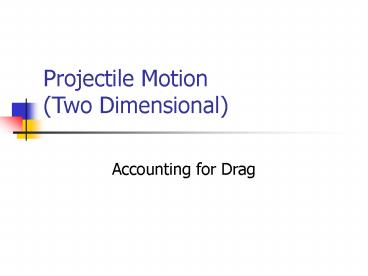Projectile Motion (Two Dimensional) - PowerPoint PPT Presentation
Title:
Projectile Motion (Two Dimensional)
Description:
(Two Dimensional) Accounting for Drag Learning Objectives Know the equation to compute the drag force on an object due to air friction Apply Newton's Second Law and ... – PowerPoint PPT presentation
Number of Views:131
Avg rating:3.0/5.0
Title: Projectile Motion (Two Dimensional)
1
Projectile Motion(Two Dimensional)
- Accounting for Drag
2
Learning Objectives
- Know the equation to compute the drag force on an
object due to air friction - Apply Newton's Second Law and the relationship
between acceleration, velocity and position to
solve a two-dimensional projectile problem,
including the affects of drag. - Prepare an Excel spreadsheet to implement
solution to two-dimensional projectile with drag.
3
Projectile Problem - No Drag
V0
y
Position
q
x
Velocity Acceleration Vx Vocos(q) ax
0 Vy Vosin(q) - g t ay -g
4
Projectile Problem - Drag
- All projectiles are subject to the effects of
drag. - Drag caused by air is significant.
- Drag is a function of the properties of the air
(viscosity, density), projectile shape and
projectile velocity.
5
General Drag Force
- The drag FORCE acting on the projectile causes it
to decelerate according to Newton's Law - aD FD/m
- where FD drag force
- m mass of projectile
6
Drag Force Due to Air
- The drag force due to wind (air) acting on an
object can be found by - FD 0.00256 CDV2A
- where FD drag force (lbf)
- CD drag coefficient (no units)
- V velocity of object (mph)
- A projected area (ft2)
7
Pairs Exercise 1
- As a pair, take 3 minutes to convert the
proportionality factor in the drag force equation
on the previous slide if the - units of velocity are ft/s, and
- the units of area are in2
8
Drag Coefficient CD
- The drag coefficient is a function of the shape
of the object (see Table 10.4). - For a spherical shape the drag coefficient ranges
from 0.1 to 300, depending upon Reynolds Number
(see next slide). - For the projectile velocities studied in this
course, drag coefficients from 0.6 to 1.2 are
reasonable.
9
Drag Coefficient for Spheres
10
Projectile Problem - Drag
- Consider the projectile, weighing W, and
travelling at velocity V, at an angle q.
- The drag force acts opposite
- to the velocity vector, V.
11
Projectile Problem - Drag
- The three forces acting on the projectile are
- the weight of the projectile
- the drag force in the x-direction
- the drag force in the y-direction
12
Drag Forces
- The total drag force can be computed by
- FD 8.264 x 10-6 (CD V2 A)
- where
- V2 Vx2 Vy2
13
Drag Forces
- The X and Y components of the drag force can be
computed by - FDx -FD cos(q)
- FDy -FD sin(q)
- where q arctan(Vy/Vx)
14
Pair Exercise 2
- Derive equations for ax and ay from FDx and FDy.
- Assuming ax and ay are constant during a brief
instant of time, derive equations for Vx and Vy
at time ti knowing Vx and Vy at time ti-1 . - Assuming Vx and Vy are constant during a brief
instant of time, derive equations for x and y at
time ti knowing x and y at time ti-1 .
15
PAIRS EXERCISE 3
- Develop an Excel spreadsheet that describes the
motion of a softball projectile - 1) neglecting drag and
- 2) including drag
More
16
PAIRS EXERCISE 3 (cont)
- Plot the trajectory of the softball (Y vs. X)
- assuming no drag
- assuming drag
- Answer the following for each case
- max. height of ball
- horizontal distance at impact with the ground
More
17
Data for Pairs Exercise 3
- Assume the projectile is a softball with the
following parameters - W 0.400 lbf
- m 0.400 lbm
- Diameter 3.80 in
- Initial Velocity 100 ft/s at 30o
- CD 0.6
- g 32.174 ft/s2 (yes, assume you are on planet
Earth)
More
18
Hints for Pairs Exercise 3
- Reminder for the AES
- F ma/gc
- where gc 32.174 (lbm ft)/(lbf s2)
- The equations of acceleration for this problem
are - ax (FDx )gc/m
- ay (FDy -W)gc/m
More
19
Considerations for Pairs Exercise 3
- What is a reasonable Dt ?
- What happens to the direction of the drag force
after the projectile reaches maximum height?
More
20
Sample Excel Spreadsheet
21
Sample Chart































